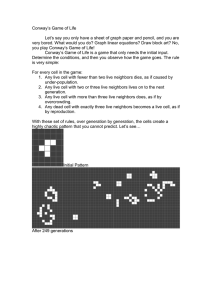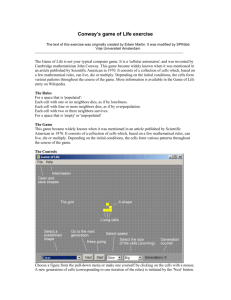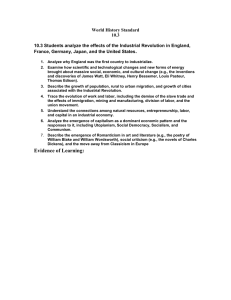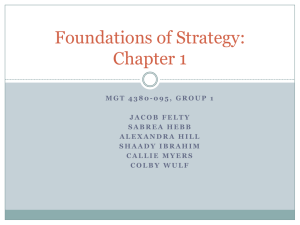Complexity and Self-Organized Criticality
advertisement
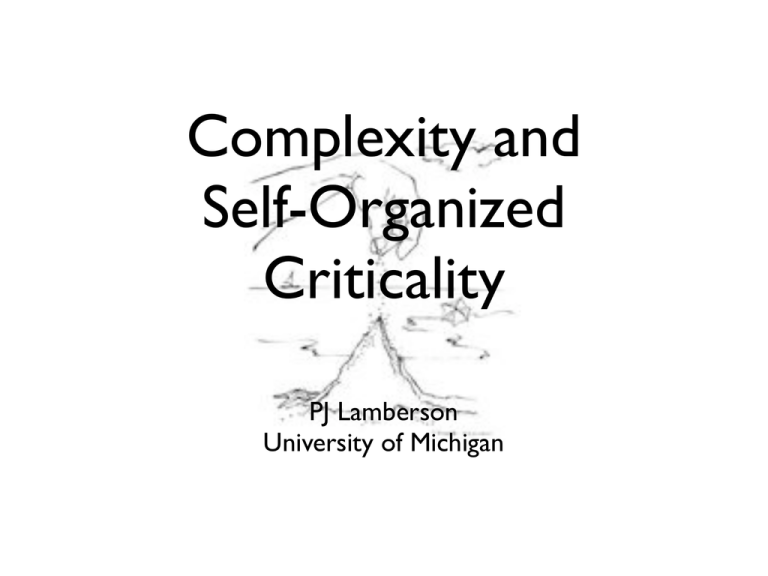
Complexity and Self-Organized Criticality PJ Lamberson University of Michigan pjlamber@umich.edu kkollman@umich.edu Send me an email with: Your name Your institution Your department Position (i.e. PhD student, postdoc, etc..) Anything else... A good definition of complex systems is hard to come by. “I will define systems with large variability as complex.” - Per Bak, How Nature Works “About thirty years ago, in the infancy of the computer era, there was a rather extensive effort, known as limits to growth, that had the goal of making global predictions. The hope was to be able to forecast, among other things, the growth of the human population and its impact on the supply of natural resources. The project failed miserably because the outcome depended on unpredictable factors not explicitly incorporated into the program. Perhaps predictions on global warming fall into the same category, since we are dealing with long-term predictions in a complex system, even though we have a good understanding of the physics of weather.” - Per Bak, How Nature Works “At most, the theory can explain why there is variability, or what typical patterns may emerge, not what the particular outcome of a particular system will be.” - Per Bak, How Nature Works “Any given outcome of this model would differ from others depending upon the random features inherent in the rules. This does not mean that the model makes no predictions. If we ran the model a hundred or a thousand times, we would get a distribution of outcomes - a cloud ... When we compare the outcome of this model to a real-world situation, we would be comparing the distribution of outcomes produced by the model t another distribution of outcomes produced by the real world - comparing clouds to clouds.” - Miller and Page, Complex Adaptive Systems p. 75 A good definition of complex systems is hard to come by. It’s clear that emergence is a crucial part of the puzzle. “The hallmark of emergence is the sense of much coming from little.” - John Holland, Emergence Emergence: A macro level pattern that is not obvious from the micro level interactions that lead to it. Where is the problem with this definition? obvious is subjective Conway’s Game of Life Live Dead Conway’s Game of Life Each cell interacts with its 8 neighbors Conway’s Game of Life live cell with less than 2 live neighbors • Any dies (loneliness). live cell with more than 3 live neighbors • Any dies (overcrowding). live cell with 2 or 3 live neighbors • Any survives unchanged. dead cell with exactly 3 live neighbors • Any comes to life. Emergence The game can produce: •static patterns (still-lifes) •repeating patterns (oscillators) •translating patterns (spaceships) •patterns that emit spaceships (guns) •patterns that move and leave a trail (puffers) •patterns that move and emit spaceships (rakes) Power Laws • “Big events” happen rarely. events” happen much more • “Small frequently. Power Laws ! f(x)=cx log f(x)=log c + ! log x So, the graph of f(x) is linear on a log-log scale. Power Laws a. Words in Moby Dick b. Scientific citations c. Website hits d. Bestselling books e. Telephone calls received f. Earthquake magnitudes g. Moon crater diameters h. Solar flare intensity i. War intensity j. Individual wealth k. Family name frequency l. City population “Darwin and Einstein correspondence patterns” João Gama Oliveira and Albert-László Barabási Nature 437 (2005) Preferential Attachment http://expertvoices.nsdl.org/cornell-info204/2007/04/15/networks-the-phenomenon-of-the-rich-get-richer/ The Web in Africa http://www2002.org/CDROM/poster/164/ Firm Sizes “Zipf Distribution of U.S. Firm Sizes” Robert L. Axtell, et al. Science 293, 1818 (2001) Preferential Attachment (The Yule Process) Preferential Attachment (The Yule Process) Let us start with a single page, with a link to itself. At each time step, a new page appears, with outdegree 1. With probability ! < 1, the link for the new page points to a page chosen uniformly at random. With probability 1"!, the new page points to page chosen proportionally to the indegree of the page. Then the indegree (or outdegree) distribution of the resulting web follows a power law. Yule Process 2 Suppose that species appear, but never die. Species are added to genera by splitting into to species. Suppose this happens randomly at a constant rate, so that a genus with k species gains new species at a rate proportional to k. Every m speciation events, a new genus is formed. Then the distribution of the number of species per genus follows a power law. Typing Monkeys Typing Monkeys A monkey types randomly on a keyboard with n characters and a space bar. A space is hit with probability q; all other characters are hit with equal probability (1" q)/n. A space is used to separate words. Random Walks (Gambler’s Ruin) Imagine a gambler that starts a night of gambling with no money. The friendly house lets him play his first game for free, but kicks him out if he ever runs out of money again. He plays a simple game: the probability of winning is .5, and each time he wins he gets a dollar, each time he loses he pays a dollar. The probability distribution for the length of time the gambler plays before running out of money is a power law with exponent 3/2. Percolation (Forest Fires) At the critical point (.59274...), the distribution of cluster sizes follows a power law. Self-Organized Criticality (Forest Fires 2) Trees grow instantaneously at some constant rate. Occasionally, (at some constant probability), lightning strikes and starts a forest fire if it hits a tree. The size of clusters and the size of fires converges to a power law. Trust me, anyone can come up with a power law model. The challenge is figuring out how to show your model is actually right. -Michael Mitzenmacher http://geomblog.blogspot.com/2005/10/darwins-and-einsteins-email.html
